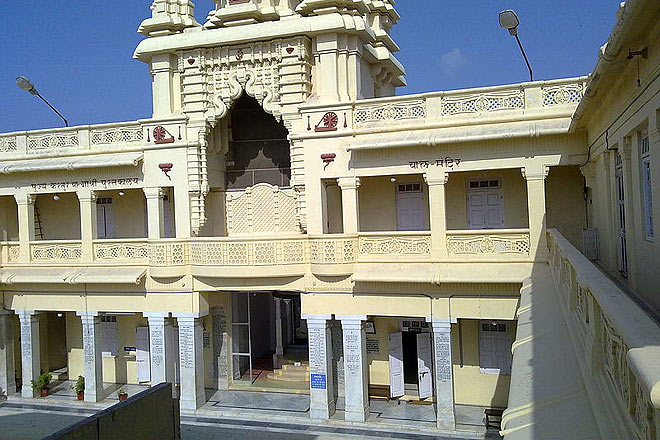Kirti Mandir, Porbandar, Gujarat On October 2, 1859, a son was born to Karamchand Uttamchand Gandhi, the Diwan
Sabarmati Ashram, Ahmedabad, Gujarat
Home to Gandhi from 1917 and 1930, the Sabarmati Ashram (also known as Harijan Ashram) was established by Gandhi after his return from South Africa. He chose this spot on the bank of the Sabarmati River as he wanted to experiment with a life of farming, animal husbandry and weaving. It was from here in March 12, 1930, that he launched the Dandi March to protest against the British Salt Law in India. The cottage where Gandhi lived, Hriday Kunj (gandhiashramsabarmati.org), tops the list of attractions within the complex. The Charles Correa-designed museum contains three galleries—the Gandhi in Ahmedabad Gallery, the Painting Gallery and the My Life is My Message Gallery—and houses the Ashram’s library. The Museum is open daily from 8.30am to 6.30pm. There’s no admission fee.
Mani Bhavan, Mumbai, Maharashtra
Between 1917 and 1934, Gandhi would often reside at his friend Revashankar Jagjeevan Jhaveri’s house, Mani Bhavan (gandhi-manibhavan.org), located in the Gamdevi neighbourhood of Mumbai. The house has been a witness to many important chapters in Gandhian history, including his Satyagraha against the Rowlatt Act. The house was converted to a museum in 1955. On the second floor, the room where Gandhi lived and worked, is preserved in its original setting. Adjoining this room is an exhibition depicting Gandhi’s life through miniature figures. The library contains a huge collection of books on Gandhi. The museum is open to all from 9.30am to 6pm.
Magan Sangrahalaya, Wardha, Maharashtra
After he left the Sabarmati Ashram, Mahatma Gandhi settled in Maganwadi in Wardha, about 600km from Mumbai. It was here in 1938 that Gandhi founded the Magan Sangrahalaya (gandhifootprints.org ). Named after his then deceased friend and associate Maganlal Gandhi, a museum with rural technology as the theme. But he warned that he did not want that the museum be considered as “a window dressing for toys but a living book of self-education.” The Mahatma Gandhi wing contains memorabilia related to the great man while the Gandhi Chitra Pradarshani is a visual treat. Other wings in the complex include the Khadi and village industries wing, a rural technology wing, an organic food and health care wing and others.
Aga Khan Palace, Pune, Maharashtra
Tucked inside Pune’s Yerwada neighbourhood, the once grand Aga Khan Palace is associated with Mahatma Gandhi for many reasons. Today it has been designated a Monument of National Importance and maintained by the Archaeological Survey of India. During the Quit India movement, Mahatma Gandhi and his wife Kasturba Gandhi were kept here under house arrest along with other leaders. Kasturba Gandhi, who breathed her last here, has been memorialised through a monument built by Charles Correa. The rooms used by Gandhi and Kasturba have been turned into museum galleries containing their personal belonging as well as paintings and photographs. Entry charges apply.
Rajghat, New Delhi
One of the must-visit places in Delhi is Rajghat, a black platform with an eternal flame marking the spot where Mahatma Gandhi was cremated. You have to remove your footwear if you want to enter the spot. Located just opposite is the National Gandhi Museum (gandhimuseum.org) that contains a huge collection of original artefacts, books, journals and documents, photographs, audio-visual materials, exhibitions, art pieces and other memorabilia connected with Mahatma Gandhi and Kasturba. The museum remains open from 9.30am to 5.30pm on all days except Mondays. There are no entry or photography charges.
Gandhi Smriti Sangrahalaya, Barrackpore, West Bengal
One of the best places to learn about Mahatma Gandhi through his photographs and letters is the Gandhi Smriti Sangrahalaya (gandhimuseum.in ) in Barrackpore, about 25km north of Kolkata. Spread across the five galleries of this biographical museum are artefacts used by Gandhi, a huge collection of photographs, including some rare negatives, letters as well as sculptures and murals executed by notable artists. The Bengal Gallery and the Orissa and Noakhali Gallery depict Gandhi’s close relations with undivided Bengal and the eastern region. The museum is open from 11am to 5pm on all days except Wednesday and there’s no entry fee. Spend some time here and then visit the landscaped Gandhi Ghat on the bank of the Ganga for great sunset views. There is a memorial to mark the spot where Gandhi’s ashes were immersed in the river. Photography is strictly prohibited at Gandhi Ghat.
Tamukkam Palace, Madurai, Tamil Nadu
Housed in the renovated 17th century Tamukkam Palace that belongs to Rani Mangammal of the Nayak dynasty, the Gandhi Memorial Museum (gandhimmm.org) contains a gory reminder of the great man’s assassination—a piece of the blood stained garment he was wearing when he was shot dead by Nathuram Godse. Other exhibits include letters written by Gandhi to various people (including one to Adolf Hitler), a visual biography of Gandhi as well as a philatelic gallery.
Gandhi Sangrahalaya, Patna, Bihar
The Gandhi Sangrahalaya (gandhisangrahalayapatna.org ) in Patna has developed through the years, and now contains a picture gallery, statues, memorials, alibrary and a Gandhi Sahitya Kendra. Entrance to the museum is free.
Gujarat
Maharashtra
Mahatma Gandhi


